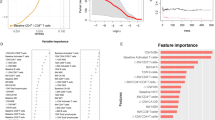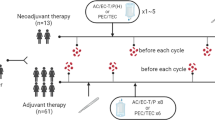Abstract
This study aimed to explore the distribution, characteristics and prognostic value of baseline peripheral blood lymphocyte subsets in patients with extranodal NK/T-cell lymphoma (NKTCL). We conducted this cross-sectional study of 205 newly-diagnosed NKTCL patients receiving first-line chemotherapy and radiation at our institute between 2010 and 2020. Baseline peripheral blood lymphocytes were detected using flow cytometry, and the clinical value was analyzed. Compared with healthy controls, patients with NKTCL presented with a distinct peripheral immunity with higher levels of cytotoxic CD8+ T cells (33.230 ± 12.090% vs. 27.060 ± 4.010%, p < 0.001) and NKT cells (7.697 ± 7.219% vs. 3.550 ± 2.088%, p < 0.001) but lower proportions of suppressive regulatory T cells (Treg, 2.999 ± 1.949% vs. 3.420 ± 1.051%, p = 0.003) and CD4+ helper T cells (Th, 33.084 ± 11.361% vs. 37.650 ± 3.153%, p < 0.001). Peripheral lymphocytes were differentially distributed according to age, stage, and primary site in patients with NKTCL. The proportion of Th cells/lymphocytes was associated with tumor burden reflected by stage (p = 0.037), serum lactate dehydrogenase (p = 0.0420), primary tumor invasion (p = 0.025), and prognostic index for NK/T-cell lymphoma (PINK) score (p = 0.041). Furthermore, elevated proportions of T cells (58.9% vs. 76.4%, p = 0.005), Th cells (56.3% vs. 68.8%, p = 0.047), or Treg cells (49.5% vs. 68.9%, p = 0.040) were associated with inferior 5-year progression-free survivals (PFS) via univariable survival analysis. Multivariate cox regression revealed elevated Th cells as an independent predictor for unfavorable PFS (HR = 2.333, 95% CI, 1.030–5.288, p = 0.042) in NKTCL. These results suggested the proportion of Th cells positively correlated with tumor burden and was a potential non-invasive biomarker for inferior survival for patients with NKTCL.




Similar content being viewed by others
References
Wang H, Fu BB, Gale RP, Liang Y (2021) NK-/T-cell lymphomas. Leukemia 35(9):2460–2468. https://doi.org/10.1038/s41375-021-01313-2
Tse E, Zhao WL, Xiong J, Kwong YL (2022) How we treat NK/T-cell lymphomas. J Hematol Oncol 15(1):74. https://doi.org/10.1186/s13045-022-01293-5
Vose J, Armitage J, Weisenburger D, International TCLP (2008) International peripheral T-cell and natural killer/T-cell lymphoma study: pathology findings and clinical outcomes. J Clin Oncol 26(25):4124–4130. https://doi.org/10.1200/JCO.2008.16.4558
Wang L, Wang JW (2020) Extranodal natural-killer T-cell lymphoma: experience from China. Lancet Haematol 7(6):e441. https://doi.org/10.1016/S2352-3026(20)30103-4
Aozasa K, Takakuwa T, Hongyo T, Yang WI (2008) Nasal NK/T-cell lymphoma: epidemiology and pathogenesis. Int J Hematol 87(2):110–117. https://doi.org/10.1007/s12185-008-0021-7
Yamaguchi M, Suzuki R, Oguchi M (2018) Advances in the treatment of extranodal NK/T-cell lymphoma, nasal type. Blood 131(23):2528–2540. https://doi.org/10.1182/blood-2017-12-791418
Qi SN, Yang Y, Song YQ, Wang Y, He X, Hu C et al (2020) First-line non-anthracycline-based chemotherapy for extranodal nasal-type NK/T-cell lymphoma: a retrospective analysis from the CLCG. Blood Adv 4(13):3141–3153. https://doi.org/10.1182/bloodadvances.2020001852
Fox CP, Civallero M, Ko YH, Manni M, Skrypets T, Pileri S et al (2020) Survival outcomes of patients with extranodal natural-killer T-cell lymphoma: a prospective cohort study from the international T-cell Project. Lancet Haematol 7(4):e284–ee94. https://doi.org/10.1016/S2352-3026(19)30283-2
Yamaguchi M, Suzuki R, Oguchi M, Asano N, Amaki J, Akiba T et al (2017) Treatments and outcomes of patients with extranodal natural killer/t-cell lymphoma diagnosed between 2000 and 2013: a cooperative study in Japan. J Clin Oncol 35(1):32–39. https://doi.org/10.1200/JCO.2016.68.1619
Zhang L, Jiang M, Xie L, Zhang H, Jiang Y, Yang QP et al (2016) Five-year analysis from phase 2 trial of “sandwich” chemoradiotherapy in newly diagnosed, stage IE to IIE, nasal type, extranodal natural killer/T-cell lymphoma. Cancer Med 5(1):33–40. https://doi.org/10.1002/cam4.569
Ding H, Chang J, Liu LG, Hu D, Zhang WH, Yan Y et al (2015) High-dose methotrexate, etoposide, dexamethasone and pegaspargase (MEDA) combination chemotherapy is effective for advanced and relapsed/refractory extranodal natural killer/T cell lymphoma: a retrospective study. Int J Hematol 102(2):181–187. https://doi.org/10.1007/s12185-015-1809-x
Jaccard A, Gachard N, Marin B, Rogez S, Audrain M, Suarez F et al (2011) Efficacy of L-asparaginase with methotrexate and dexamethasone (AspaMetDex regimen) in patients with refractory or relapsing extranodal NK/T-cell lymphoma, a phase 2 study. Blood 117(6):1834–1839. https://doi.org/10.1182/blood-2010-09-307454
Li X, Cheng Y, Zhang M, Yan J, Li L, Fu X et al (2018) Activity of pembrolizumab in relapsed/refractory NK/T-cell lymphoma. J Hematol Oncol 11(1):15. https://doi.org/10.1186/s13045-018-0559-7
Lai J, Xu P, Jiang X, Zhou S, Liu A (2017) Successful treatment with anti-programmed-death-1 antibody in a relapsed natural killer/T-cell lymphoma patient with multi-line resistance: a case report. BMC Cancer 17(1):507. https://doi.org/10.1186/s12885-017-3501-4
Yan Z, Yao S, Liu Y, Zhang J, Li P, Wang H et al (2020) Durable response to sintilimab and chidamide in a patient with pegaspargase- and immunotherapy-resistant NK/T-cell lymphoma: case report and literature review. Front Oncol 10:608304. https://doi.org/10.3389/fonc.2020.608304
Kwong YL, Chan TSY, Tan D, Kim SJ, Poon LM, Mow B et al (2017) PD1 blockade with pembrolizumab is highly effective in relapsed or refractory NK/T-cell lymphoma failing l-asparaginase. Blood 129(17):2437–2442. https://doi.org/10.1182/blood-2016-12-756841
Tao R, Fan L, Song Y, Hu Y, Zhang W, Wang Y et al (2021) Sintilimab for relapsed/refractory extranodal NK/T cell lymphoma: a multicenter, single-arm, phase 2 trial (ORIENT-4). Signal Transduct Target Ther 6(1):365. https://doi.org/10.1038/s41392-021-00768-0
Kim WY, Jung HY, Nam SJ, Kim TM, Heo DS, Kim CW et al (2016) Expression of programmed cell death ligand 1 (PD-L1) in advanced stage EBV-associated extranodal NK/T cell lymphoma is associated with better prognosis. Virchows Arch 469(5):581–590. https://doi.org/10.1007/s00428-016-2011-0
Cho J, Kim SJ, Park WY, Kim J, Woo J, Kim G et al (2020) Immune subtyping of extranodal NK/T-cell lymphoma: a new biomarker and an immune shift during disease progression. Mod Pathol 33(4):603–615. https://doi.org/10.1038/s41379-019-0392-8
Blum KS, Pabst R (2007) Lymphocyte numbers and subsets in the human blood. Do they mirror the situation in all organs? Immunol Lett 108(1):45–51. https://doi.org/10.1016/j.imlet.2006.10.009
Hung MH, Yu YB, Hsiao LT, Hong YC, Liu JH, Gau JP et al (2013) Absolute lymphocyte count predicts response to rituximab-containing salvage treatment for relapsed/refractory B-cell non-Hodgkin’s lymphoma with prior rituximab exposure. J Chin Med Assoc 76(4):195–200. https://doi.org/10.1016/j.jcma.2012.12.003
Li C, Li W, Xu G, You M, Wu W, Kuang L (2021) Relationship between the absolute lymphocyte count/absolute monocyte count ratio, soluble interleukin 2 receptor level, serum programmed cell death 1 level, and the prognosis of patients with diffuse large B-cell lymphoma. Ann. Palliat Med 10(10):10938–10945. https://doi.org/10.21037/apm-21-2551
Mohsen A, Taalab M, Abousamra N, Mabed M (2020) Prognostic significance of absolute lymphocyte count, absolute monocyte count, and absolute lymphocyte count to absolute monocyte count ratio in follicular non-Hodgkin lymphoma. Clin Lymphoma Myeloma Leuk 20(9):e606–ee15. https://doi.org/10.1016/j.clml.2020.03.007
Bansal R, Novo M, Al Saleh AS, Guerrico AG, Zhang H, Shao Z et al (2022) Peak absolute lymphocyte count after CAR-T infusion predicts clinical response in aggressive lymphoma. Am J Hematol 97(7):E241–E2E4. https://doi.org/10.1002/ajh.26561
Rai S, Inoue H, Hanamoto H, Matsuda M, Maeda Y, Wada Y et al (2021) Low absolute lymphocyte count is a poor prognostic factor for untreated advanced follicular lymphoma treated with rituximab plus bendamustine: results of the prospective phase 2 CONVERT trial. Int J Hematol 114(2):205–216. https://doi.org/10.1007/s12185-021-03148-0
Huang JJ, Jiang WQ, Lin TY, Huang Y, Xu RH, Huang HQ et al (2011) Absolute lymphocyte count is a novel prognostic indicator in extranodal natural killer/T-cell lymphoma, nasal type. Ann Oncol 22(1):149–155. https://doi.org/10.1093/annonc/mdq314
Hamdi L, Creidy R, Boudjemaa S, Hendel-Chavez H, Hugues P, Taoufik Y et al (2021) Frequent altered distribution of peripheral B-lymphocyte subsets in pediatric and adolescent patients with classical Hodgkin lymphoma. Leuk Lymphoma 62(2):300–307. https://doi.org/10.1080/10428194.2020.1834090
Lin J, Chen X, Wu H, Chen X, Hu X, Xu J (2021) Peripheral blood lymphocyte counts in patients with infectious mononucleosis or chronic active Epstein-Barr virus infection and prognostic risk factors of chronic active Epstein-Barr virus infection. Am J Transl Res 13(11):12797–12806. eCollection
International Non-Hodgkin’s Lymphoma Prognostic Factors P (1993) A predictive model for aggressive non-Hodgkin’s lymphoma. N Engl J Med 329(14):987–994. https://doi.org/10.1056/NEJM199309303291402
Yang Y, Zhang YJ, Zhu Y, Cao JZ, Yuan ZY, Xu LM et al (2015) Prognostic nomogram for overall survival in previously untreated patients with extranodal NK/T-cell lymphoma, nasal-type: a multicenter study. Leukemia 29(7):1571–1577. https://doi.org/10.1038/leu.2015.44
Lee J, Suh C, Park YH, Ko YH, Bang SM, Lee JH et al (2006) Extranodal natural killer T-cell lymphoma, nasal-type: a prognostic model from a retrospective multicenter study. J Clin Oncol 24(4):612–618. https://doi.org/10.1200/JCO.2005.04.1384
Kim SJ, Yoon DH, Jaccard A, Chng WJ, Lim ST, Hong H et al (2016) A prognostic index for natural killer cell lymphoma after non-anthracycline-based treatment: a multicentre, retrospective analysis. Lancet Oncol 17(3):389–400. https://doi.org/10.1016/S1470-2045(15)00533-1
Shin HJ, Kim DY, Chung J, Shin KH, Lee H (2021) Prognostic impact of peripheral blood T-cell subsets at the time of diagnosis on survival in patients with diffuse large B-cell lymphoma. Acta Haematol 144(4):427–437. https://doi.org/10.1159/000510912
Dawson CW, Port RJ, Young LS (2012) The role of the EBV-encoded latent membrane proteins LMP1 and LMP2 in the pathogenesis of nasopharyngeal carcinoma (NPC). Semin Cancer Biol 22(2):144–153. https://doi.org/10.1016/j.semcancer.2012.01.004
Laddaga FE, Ingravallo G, Mestice A, Tamma R, Perrone T, Maiorano E et al (2022) Correlation between circulating blood and microenvironment T lymphocytes in diffuse large B-cell lymphomas. J Clin Pathol 75(7):493–497. https://doi.org/10.1136/jclinpath-2020-207048
Porrata LF, Ristow K, Witzig TE, Tuinistra N, Habermann TM, Inwards DJ et al (2007) Absolute lymphocyte count predicts therapeutic efficacy and survival at the time of radioimmunotherapy in patients with relapsed follicular lymphomas. Leukemia 21(12):2554–2556. https://doi.org/10.1038/sj.leu.2404819
Kusano Y, Yokoyama M, Terui Y, Nishimura N, Mishima Y, Ueda K et al (2017) Low absolute peripheral blood CD4+ T-cell count predicts poor prognosis in R-CHOP-treated patients with diffuse large B-cell lymphoma. Blood Cancer J 7(4):e558. https://doi.org/10.1038/bcj.2017.37
Author information
Authors and Affiliations
Contributions
Jun Zhu, Yuqin Song: conceptualization and methodology. Fei Qi: data curation. Fei Qi: writing original draft preparation. Yuce Wei: revising the manuscript and editing. Meng Wu, Yan Sun, and Yan Xie: formal analysis. Weiping Liu and Weihu Wang: supervision.
Corresponding authors
Ethics declarations
Human ethics and consent to participate
Not applicable.
Competing interests
The authors declare no competing interests.
Additional information
Publisher’s note
Springer Nature remains neutral with regard to jurisdictional claims in published maps and institutional affiliations.
Supplementary information

Supplementary Figure 1
Linear regression within different lymphocyte subsets in NKTCL. (PNG 539 kb)
Rights and permissions
Springer Nature or its licensor (e.g. a society or other partner) holds exclusive rights to this article under a publishing agreement with the author(s) or other rightsholder(s); author self-archiving of the accepted manuscript version of this article is solely governed by the terms of such publishing agreement and applicable law.
About this article
Cite this article
Qi, F., Wei, Y., Wu, M. et al. Immunotyping of peripheral blood lymphocytes by flow cytometry reveals Th cell as a potential prognostic biomarker for extranodal NK/T-cell lymphoma. Ann Hematol 103, 1643–1653 (2024). https://doi.org/10.1007/s00277-023-05605-8
Received:
Accepted:
Published:
Issue Date:
DOI: https://doi.org/10.1007/s00277-023-05605-8




